An ambitious growth plan released by the City of Saskatoon on Wednesday is calling for a more connected bike lane structure downtown, including making lanes on 4th Avenue and 23rd Street permanent.
The report outlines the city’s desire to make downtown more friendly to alternate modes of transportation, and also details plans for bus rapid transit (BRT).
Among the ideas proposed is connecting the current bike lanes on 4th Ave. and 23rd St. to new lanes that would be installed on 19th Street and a raised bicycle path on either side of Idylwyld Drive.
The paths along 19th and Idylwyld aren’t expected to eliminate any existing parking spaces, but the Idylwyld track would reduce traffic lanes to six from the current seven.
Jay Magus, acting director of transportation, told reporters the introduction of Circle Drive South Bridge, the north commuter parkway project and the re-opening of Traffic Bridge relieve a lot of traffic from Idylwyld Dr., meaning a lane can be taken away.
“The function has changed,” he said. “We want to make it a downtown street.”
He said the hope is to give cyclists a corridor to the downtown, while also bringing storefronts closer to the road.
Magus added drivers between 25th Street and 19th St. mostly condense into fewer lanes on Idylwyld Dr., despite more road being available.
“At one point there’s seven lanes of asphalt, but only three or four are being used,” he said.
“The rest is really a waste.”
The move to keep the lanes on 4th Ave. and 23rd St. comes despite a fall 2017 survey indicating 66 per cent of residents were opposed to the placement.
In November, Ward 4 councillor Troy Davies advocated for the lanes to be removed from 4th Ave.
“The numbers don’t lie,” he said at the time.
Making the lanes permanent would remove 13 parking spaces on 23rd Street and 58 spaces on 4th Ave.
Magus said other routes were considered, but moving from 4th Ave. to Spadina Crescent would be “redundant” due to the Meewasin trail.
BRT Plans Include Special Lanes, Traffic Signals
Other routes considered for bike lanes were eliminated because of the city’s plans for BRT routes through downtown.
Detailed route plans prepared by city staff and consulting firm HDR were released along with the bike lane plans, proposing three separate rapid routes through Saskatoon.
All three BRT routes are slated to use 3rd Avenue as a north-south corridor, as well as 22nd and 25th Street.
A red line would travel along 8th Street from Rosewood, turn right on Preston Avenue, then head towards downtown along College Drive. Once downtown, it would cut down 3rd Avenue to 22nd Street and continue to the western edge of the city.
A blue line is planned to start on the south end of Preston Ave., travelling north before turning left on 8th Street, turning right on Broadway Ave. to access downtown via 19th Street and 3rd Avenue. The route would then turn briefly onto 25th Street, right onto Idylwyld Drive, right onto 33rd Street and north along Warman Road to Lawson Heights.
The green line would start at the Erindale shopping centre at Attridge Dr. and McOrmond Dr., travel along Attridge/Preston to College Drive and into the downtown via University Bridge. After turning onto 3rd Avenue, it would follow 22nd Street before stopping at Confederation Mall.
Plans for BRT also include dedicated bus lanes along 3rd Avenue in the downtown core, College Drive between Clarence Ave. and Preston Ave. and Broadway Ave. between 12th St. and 8th St.
Michael Moellenbeck, acting director of transportation, said buses using the special lanes would also have their own traffic signals to help them “jump the que” at busy intersections if they’re running late.
Additional lanes could also be installed shortly before other intersections along the BRT route with similar technology.
“Instead of being stuck in traffic, we have a way to route it around that traffic,” he said, noting the special signals could help alleviate delays caused by rail crossings.
Director of Planning and Development Lesley Anderson noted 3rd Ave. and Broadway Ave. were chosen as routes for BRT because of the foot traffic the streets see as opposed to other north-south corridors with room for specialized lanes.
She added the infrastructure ideas for the city’s core also took the possibility of a downtown arena into consideration.
“It’s definitely been kept in mind,” she said. “The locations we’ve identified will all adequately meet the needs of a downtown arena.”
The plans will be discussed at a special governance and priorities committee meeting on June 20.











